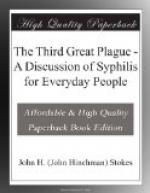Chapter VIII
The Treatment of Syphilis (Continued)
SALVARSAN
+The Discovery of Salvarsan ("606").+—Salvarsan, or “606,” is a chemical compound used in the modern treatment of syphilis. It was announced to the world by Paul Ehrlich, its brilliant discoverer, in December, 1910. Ehrlich and his Japanese co-worker, Hata, had some years before been impressed with the remarkable effect certain dyes had on the parasites infesting certain animals and which resemble the germs that cause the African sleeping sickness in man. When one of these dyes was dissolved and injected into the blood of the sick animal, the dye promptly picked out and killed all the parasites, but did not kill the animal. Dyes are very complex chemical substances and certain of them seem to have an affinity for germs. It occurred to Ehrlich that if a substance could be devised which was poisonous for the germ and not for the patient it might be possible to prepare a specific for a given disease, acting as quinin does in malaria. By combining a poison with a dye it might be made to pick out the germs and leave the body unharmed.
[Illustration: Paul Ehrlich [1854-1915]
(From “Year Book of
Skin and Venereal Diseases,” 1916, vol. ix.
“Practical Medicine
Series,” Year Book Publishers, Chicago.)]
The poison which had already been shown to be especially effective in killing germs like those of syphilis was arsenic. The problem was to get arsenic into such a combination with other chemical substances that it would lose its poisonous quality for man, but still be poisonous for the spirochete of syphilis. Ehrlich and Hata began to make chemical compounds of arsenic in the laboratory with chemical substances like the dyes. As the compounds grew more complex they were tested on animals and some of them found to have the qualities for which their inventors were searching. Some of them are even used at the present time in the treatment of certain diseases. The six hundred and sixth compound in this series, when tested on syphilitic animals, was found to be extraordinarily efficient in killing the germ of syphilis, even when used in quantities so small as not to injure the animal. Among other things, there could be no better example of the importance of animal experiment in medicine.




